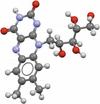issue contents
December 2021 issue

Cover illustration: The crystal structure of the stable form of vitamin B2 or riboflavin was solved using high-resolution powder X-ray diffraction. The starting structural model was generated using a Monte Carlo simulated annealing method. The positions of the H atoms belonging to hydroxy groups were estimated from computational energy minimizations. See Guerain, Affouard, Henaff, Dejoie, Danède, Siepman, Siepman & Willart [Acta Cryst. (2021), C77, 800–806].
letters to the editor
research papers










 access
access







addenda and errata


 journal menu
journal menu




























